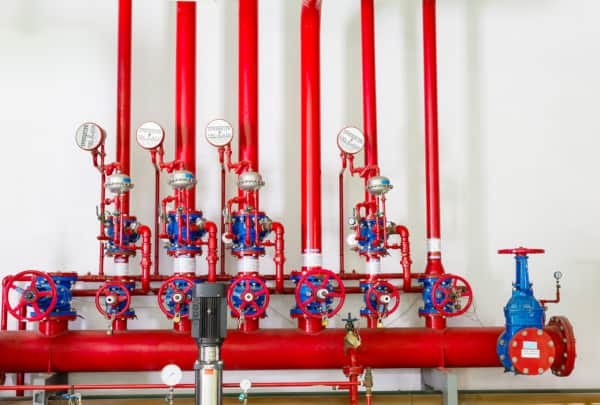
#233 – What is a Fire Riser Room? IFC and NFPA Requirements
When seconds count during an emergency, they provide easy access to fire protection system controls and equipment
Most people hurry past it in the building they live or work in without giving it a second thought. But as the control center for a fire sprinkler system, the fire riser room plays a critical role in a building’s fire protection—and knowing where it is, why it matters, and what equipment is stored inside can make all the difference during an emergency.
Until now, there hasn’t been a whole lot of information out there about fire sprinkler riser rooms that doesn’t require wading through pages of complicated fire and building codes. In this blog, we examine why riser rooms are important, what’s tucked behind their doors, and what the codes and standards require.

Be sure to check out our selection of pre-assembled riser kits—making sprinkler system design and installation faster for commercial and residential applications—as well as our fire sprinkler riser room signage that helps your riser room stay up to standard.
Fire sprinkler riser rooms: a dedicated space for fire protection equipment
In a nutshell, a fire sprinkler riser room is a dedicated space for fire protection equipment situated on an outside wall at grade with direct exterior access. It provides an accessible, single location for workers and emergency personnel to quickly locate fire sprinkler controls and equipment, including:
- The overall sprinkler riser, the main component of a sprinkler system that serves as a bridge between the water supply and sprinkler pipes in a building, and contains many of the following devices:
- Valves for draining, isolating, and testing the system
- Pressure gauges that measure whether sprinkler systems are in service and maintaining proper water pressure, as well as air pressure in dry sprinkler systems.
- The backflow prevention device, which protects municipal water supplies from pollution and contamination by only allowing water to flow in one direction
- In dry sprinklers, a dry pipe valve that holds back the water supply until a sprinkler head activates, as well as other dry system components like riser-mounted air compressors that pressurize sprinkler pipes
- A water flow switch that activates an alarm(s)
- The primary water input for the sprinkler system
- A water motor gong, or a bell that sounds when water flows through the sprinkler system—often installed on the outside wall of the sprinkler riser room
- Tamper switches connected to fire protection valves that signal a warning if the valve partially or fully closes
- Piping that connects the system riser to the fire department connection, enabling firefighters to supplement the system’s water supply
- Often, the cabinet that stores spare sprinkler heads and compatible sprinkler wrenches for replacing deployed or damaged ones. It’s also helpful to store a copy of NFPA 25: Standard for the Inspection, Testing, and Maintenance of Water-Based Fire Protection Systems in the cabinet for reference during inspection or testing.
Watch this video for a tour of a typical fire riser room:
A large building could have multiple sprinkler systems that require multiple risers, making it important to carefully label the floor area each valve controls so workers and emergency personnel can quickly find the equipment they need. In fact, many fire departments require property owners to mount a building floor plan on the wall in the riser room that shows which control valves are responsible for each part of the building.
NFPA 13: Standard for the Installation of Sprinkler Systems also sets strict instructions for labeling critical equipment (like control valves) that’s located within the riser room. These requirements are discussed in detail in our previous blog, “Complete Guide to Sprinkler System Signs and Marking.”
Assembling the fire protection system controls in a single room is a convenience that can save precious time as an emergency unfolds. It can also help prevent costly water damage caused by accidental sprinkler discharges or leaks by enabling building personnel to quickly locate and shut off the correct control valve.
In some instances, the system’s fire pump and fire alarm control panel are also located in the sprinkler riser room, and additional signage is required if they are. And some local codes require riser rooms to house remote unit fire alarm panels connected to the master fire alarm panel in multi-family residential occupancies.
Rooms that include fire pumps also carry more robust construction and design requirements specified by NFPA 20: Standard for the Installation of Stationary Pumps for Fire Protection. Of course, not every sprinkler system requires a fire pump, and some fire industry professionals believe the most desirable location for the fire pump is in a separate building from the one being protected, giving firefighters easy access to the pump and its controllers and affording it the greatest protection from fires or other hazards that could hinder its operation.
Fire codes offer specific criteria for the design and construction of fire sprinkler riser rooms
Riser rooms are generally designated within apartment buildings, condominiums, commercial buildings, and other locations that rely on fire sprinkler or standpipe systems as the first line of defense for fire protection.
The International Code Council’s (ICC) International Building Code (IBC), the model building code that most U.S. jurisdictions have adopted as a base standard, doesn’t require riser rooms but offers specific criteria for their design and construction when they’re provided. Riser rooms also must meet the requirements of ICC’s International Fire Code (IFC), which addresses fire protection in completed, occupied buildings.
Many local codes expand upon these requirements with more detailed riser room mandates, so it’s always important to check with your specific authority having jurisdiction (AHJ) to ensure your property will pass muster. The intent of the code is to ensure protection for the equipment within these rooms since it’s continued operation is critical to safeguarding people and property during a fire.
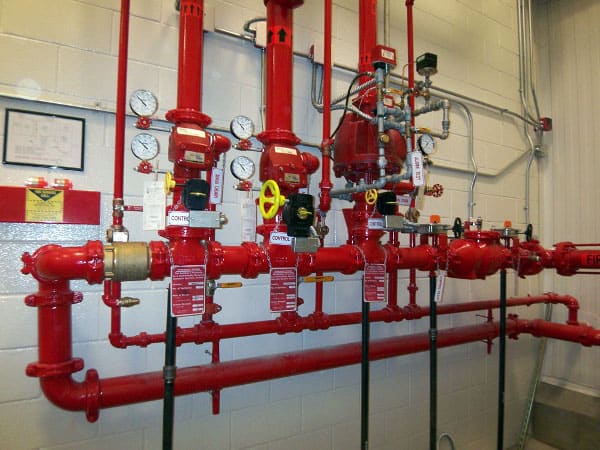
Regulations recognize that essential maintenance is challenging without proper clearance in riser rooms
In recent years, the ICC has continued to emphasize the importance of fire sprinkler riser rooms by expanding upon its requirements. In 2012, it required rooms housing fire protection systems to be adequately sized to facilitate maintenance. The code recognized that maintenance essential to a system’s longevity can be challenging if enough clearance isn’t provided to allow workers access for the removal of large or cumbersome components such as control valves or alarm check valves.
The IFC doesn’t specify its own measurements but defers to clearances specified by equipment manufacturers for installation or removal, with a goal of not having to remove doors, walls, or finishing materials within the riser room. It also states that the size of the door serving a riser room must be large enough to accommodate the removal of the largest piece of equipment it houses.
Many local regulations offer more specific measurements, such as these typical fire pump and riser room clearance amendments to the IFC from Lynnwood, WA’s 2019 Municipal Code:
“Such rooms shall be of a size that will allow a minimum of 36-inch clearance around all portions of the fire pump assembly and in front of the fire alarm panel(s). All risers shall have a minimum of 36″ clear space at the front and 18″ on the remaining sides.”
Based on the IFC and various local code requirements, it’s wise for building designers to work with fire protection system contractors early in the design process to ensure they create the necessary space and openings for equipment maintenance in riser rooms. A property’s fire protection system is usually designed around the time building construction drawings and specifications are reviewed by the AHJ.
From the 2018 edition of IFC
901.4.6 Pump and riser room size. Where provided, fire pump rooms and automatic sprinkler system riser rooms shall be designed with adequate space for all equipment necessary for the installation, as defined by the manufacturer, with sufficient working space around the stationary equipment. Clearances around equipment to elements of permanent construction, including other installed equipment and appliances, shall be sufficient to allow inspection, service, repair or replacement without removing such elements of permanent construction or disabling the function of a required fire-resistance-rated assembly. Fire pump and automatic sprinkler system riser rooms shall be provided with doors and unobstructed passageways large enough to allow removal of the largest piece of equipment.
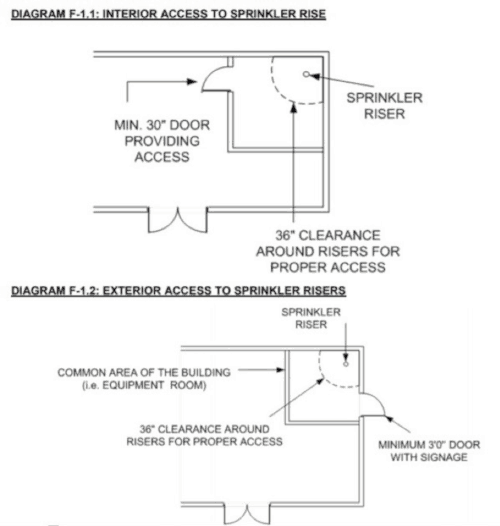
2018 fire code expands requirements
In 2018, the ICC emphasized the importance of riser rooms by adding even more requirements. The latest IFC code demands that riser rooms are easily accessible at all times through unobstructed passageways, but clarifies that they can be locked to prevent vandalism if a key is readily available to people who must access the room. Placing a key box listed to UL 1037 outside the room is a valid option.
From the 2018 edition of IFC
901.4.6.1 Access. Automatic sprinkler system risers, fire pumps and controllers shall be provided with ready access. Where located in a fire pump room or automatic sprinkler system riser room, the door shall be permitted to be locked provided the key is available at all times.
506.1 Where required. Where access to or within a structure or an area is restricted because of secured openings or where immediate access is necessary for life-saving or fire-fighting purposes, the fire code official is authorized to require a key box to be installed in an approved location. The key box shall be of an approved type listed in accordance with UL 1037, and shall contain keys to gain necessary access as required by the fire code official.

Signage
To ensure that a riser room is readily identified, the IFC requires signage on its access doors with letters that stand at least 2” in height and have a minimum stroke of 3/8”, so they are easily visible. Weather-resistant signs are also recommended. Once again, local ordinances may have additional requirements.
For instance, the Town of Brighton, N.Y., stipulates the following for fire sprinkler riser room signage: “7 inches high by 10 inches width with 0.5-inch letter stroke white reflective letters on a red background, and shall be permanently attached, at normal eye level to the door leading to the fire sprinkler control equipment.”
From the 2018 edition of IFC
901.4.6.2 Marking on access doors. Access doors for automatic sprinkler system riser rooms and fire pump rooms shall be labeled with an approved sign. The lettering shall be in a contrasting color to the background. Letters shall have a minimum height of 2 inches (51 mm) with a minimum stroke of 3/8 inch (10 mm).
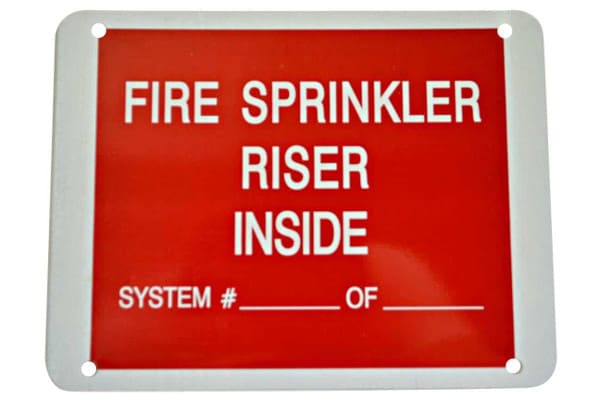
Environment
The IFC requires that the riser room’s ambient temperature be maintained at 40°F (4°C) or higher via a permanently installed heating device to ensure the system piping and components don’t freeze. This same temperature threshold is required for fire-pump rooms in NFPA 20 and valve rooms in NFPA 13. It is also the threshold NFPA 13 uses to determine whether dry sprinkler systems should be installed. Permanent lighting is now required in riser rooms as well.
From the 2018 edition of IFC
901.4.6.3 Environment. Automatic sprinkler system riser rooms and fire pump rooms shall be maintained at a temperature of not less than 40ºF (4ºC). Heating units shall be permanently installed.
901.4.6.4 Lighting. Permanently installed artificial illumination shall be provided in the automatic sprinkler system riser rooms and fire pump rooms.
And since dry systems have water in some of the pipes near the water source, NFPA specifically requires a lighted and heated valve room for dry sprinklers that shields the water pipes and dry pipe valve from cold.
The 2019 edition of NFPA 13 states that the dry pipe valve and supply piping must be kept in an area where the ambient temperature consistently stays above 40°F (4°C) (A.8.2.5.1). And the 2017 edition of NFPA 25: Standard for the Inspection, Testing, and Maintenance of Water-Based Fire Protection Systems requires daily inspections to ensure that the valve room is adequately heated when temperatures fall below freezing (13.4.5.1.1). Inspections can increase to weekly if a low-temperature alarm is installed (13.4.5.1.1.1).
From the 2019 edition of NFPA 13
8.2.5.2.1 Valve rooms shall be lighted and heated.
8.2.5.2.2 The source of heat shall be of a permanently installed type.
8.2.5.2.3 Heat tape shall not be used in lieu of heated valve enclosures to protect the dry pipe valve and supply pipe against freezing.
NFPA 13 qualifies that valve rooms aren’t necessary when dry valves are only exposed to cold temperatures for short, occasional snippets of time, however.
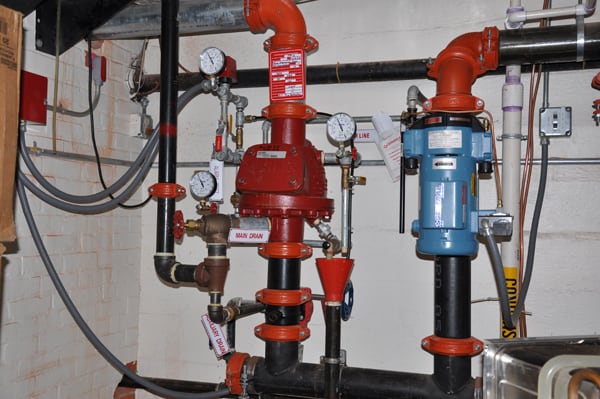
Improper use for storage
Facility managers and building owners should also keep this in mind: A common fire code infraction is cluttering fire sprinkler riser rooms with storage of non-fire protection equipment, such as file cabinets, shelving, buckets, and cleaning supplies. These extra items are not permitted because they can slow down accessing valves during an emergency when quick actions must be taken.
If fire pumps are operating within the room, it’s also imperative that both emergency and maintenance personnel have the space to work.
From the 2018 edition of IFC
509.2 Equipment access. Approved access shall be provided and maintained for all fire protection equipment to permit immediate safe operation and maintenance of such equipment. Storage, trash and other materials or objects shall not be placed or kept in such a manner that would prevent such equipment from being readily accessible.
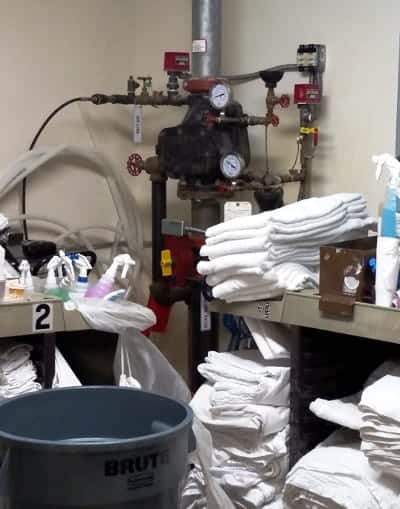
Central locations increase the efficiency of fire sprinkler systems
Sprinkler riser rooms must be located on the ground floor, with a door that’s directly accessible from the outside. But fire code also gives property owners some leeway in determining their exact location within a building.
Generally, riser rooms are situated where the water service enters a building, which is often predetermined by site conditions or local ordinances. But when possible, the location of the riser room should be carefully considered in a building’s design; a centrally located spot ensures a more efficient system and adequate water flow throughout a property. In fact, many local ordinances require centrally located riser rooms.

The riser room’s location can impact a sprinkler system’s installation costs as well. For instance, if the riser room is placed at the far end of a large industrial building, installers will most likely have to increase the pipe size to remote systems.
Important factors to consider when choosing a location for the riser room include:
- Easy access for the fire department
- The best hydraulic location for all systems
- Adequate space to access valves
- Location of the fire department connection or connections—as well as the domestic demand, if there’s a combined water service
Properly designed, cleared, and marked fire riser rooms can make all the difference during an emergency
When time is of the essence during an emergency, a clearly marked, unobstructed fire riser room can make all the difference, giving emergency personnel a central location to easily access a fire protection system’s controls. Understanding how to properly design and maintain these rooms—to protect the lifesaving equipment they contain—is key to ensuring fire sprinklers perform as intended during a fire.
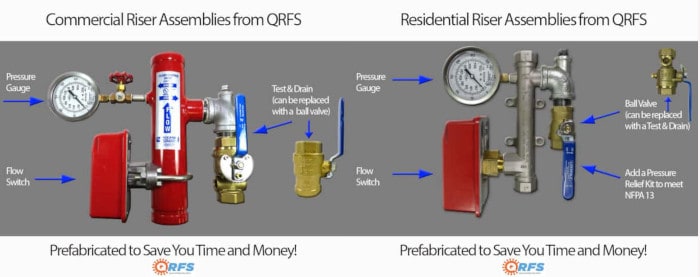
Be sure to check out our selection of pre-assembled riser kits—making sprinkler design and installation faster and sometimes less expensive for commercial and residential applications—as well as our fire sprinkler riser room signs that help ensure your riser room meets code.
Questions about QRFS products or need a brand or item that’s not in our online inventory? Just call us at +1 (888) 361-6662 or email support@qrfs.com.
This blog was originally posted at blog.qrfs.com. Check us out at Facebook.com/QuickResponseFireSupply or on Twitter @QuickResponseFS.